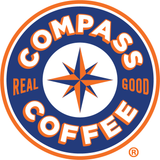The Story of Chai Syrup: “Everything Has to be as Good as the Coffee”
At Compass Coffee we have a motto, an ethos, that everything has to be as good as the coffee. That philosophy applies to everything we make — including our Simple Syrups. When we first looked at the syrups on the market, we found nothing but chemicals and artificial flavors. That didn’t sit right with us. If we were going to add syrups to our menu, they had to meet the same uncompromising standards as our coffee: real, simple ingredients.
Of all the syrups we’ve ever made, we have to say that chai is the one that best embodies our mission: culinary craftsmanship, continuous improvement, and a commitment to quality that never wavers. So without further ado… this is the story of how chai syrup became part of Compass’s DNA.
Chai Origins: Michael’s “Baby”
In the early days of Compass, long before we had a state-of-the-art production facility, our syrups were made in a tiny kitchen we nicknamed the “Chinatown Saucery.” Equipped with just two small induction burners, we cooked up everything ourselves, experimenting with recipes late into the night. Eventually, customer demand for our syrups became so high that we created an entire role for it — “Saucer-er,” which, you guessed it, is a dedicated position to handle syrups and sauces.

But there was one syrup that Michael, our CEO and founder, refused to delegate: chai.
Chai wasn’t just another menu item for Michael; it was his passion project. His baby. Crafting chai syrup wasn’t quick or easy – it took three days to brew each batch, often spilling over into weekends. Dates with Michael frequently included “chai check-ins,” which were cute at first, but, by chai check-in #7, maybe not so much... Still, Michael’s obsession with getting the flavor just right set the tone for what Compass was all about: putting in the work to create something truly exceptional.
Scaling Up: From 5-Gallon Batches to 150

As Compass grew to five cafes by 2017, brewing chai in small, 5-gallon batches became unsustainable. That’s when we partnered with our friends at Atlas Brewers, who let us use their massive brewing equipment. Overnight, we scaled up from 5 gallons to 150 gallons per batch — a total game-changer for efficiency.
But scaling up didn’t mean cutting corners. We stuck with the same high-quality ingredients, tweaking the process to adapt to the larger equipment. Of course, scaling introduced new challenges, like coarse ginger destroying the chopper (lesson learned), but we were determined to make it work without compromising on quality. (Shoutout to Justin and the Atlas team for helping us make this leap!)
The First Brewing Tank

One of the biggest turning points in our chai journey came during a random (but serendipitous) trip to the International Brewers Convention. At the time, Compass was serving coffee at the Washington Convention Center, where the Brewers Convention was being held. It was the kind of event that attracted industry pros from all over the world, and by sheer luck, it also happened to be at the same time Michael was struggling with chai production bottlenecks. During a break from our coffee service, Michael wandered into the convention hall and found himself surrounded by brewing equipment of every kind. There, among all the high-tech machinery, we spotted our first brewing tank — a 150-gallon beauty that we could actually afford.
After purchasing the tank (at a steep discount, because it was a floor model and the seller didn’t want to ship it back), we set it up at Union Kitchen, a shared workspace we used alongside other small businesses like Vegi Confetti and Milk Cult. For the first time, we had a dedicated setup for brewing chai in larger batches. The tank solved a lot of problems, but the process still required hands-on craftsmanship — like adding spices by hand — and endless trial and error.
Continuous Innovation: Challenges and Breakthroughs
Every step in scaling chai production brought new challenges — and new opportunities to improve. For example, adjusting the spice and sweetness ratios to maintain consistency in large batches took time and care. But we never gave up on keeping the process personal, adding spices by hand to preserve the flavor we were known for. (Throwback to Michael’s long hair days)

Union Kitchen also taught us valuable lessons in efficiency, like sloping floors for better cleaning. These small breakthroughs paved the way for the Ivy City production line we’d build years later. Every challenge, whether it was coarse ginger or the limits of our equipment, became a chance to level up.
Chai’s Role in the Compass Journey
By the time chai syrup became a staple across our cafes, it had also become symbolic of what Compass stands for: a relentless commitment to excellence. From Michael’s late-night weekend brews to massive 150-gallon batches, every challenge we overcame reflected the values that drive Compass: ingenuity, perseverance, and a refusal to settle for “good enough.”
Chai wasn’t just a syrup—it was a story. A journey. A reminder that growth doesn’t have to mean sacrificing quality.
Full Circle: Chai Today


Today, chai syrup is made in a state-of-the-art facility, but the recipe remains the same. The production process is more streamlined, thanks to incredible team members like Kaitlyn and Tripp, who’ve carried the torch forward. Every batch of chai we make is a testament to how far we’ve come—and a reflection of how much we’ve stayed the same.
The story of our chai syrup is more than just the story of a recipe. It’s a story of growth, passion, and craftsmanship. It’s proof that when you care deeply about what you’re making, that care shines through in every cup.




